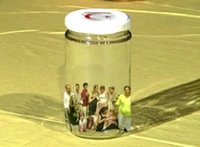Snapshot: Barred From Entry
Then we left the army camp and drove a few miles down the road to Kormakitis, the largest of the traditional Maronite villages in Cyprus. It’s a shambles now, with a few elderly Maronites living in rundown houses. By last summer, the residents had dwindled to 110—most of them over 70 years old—down from a population that they estimated had peaked at almost 1500 before the 1974 war. The villagers told me that the authorities on the Turkish side required them to fly the Turkish and Turkish Cypriot flags that I saw waving over the village cafe; and that when they tried to fly a Lebanese flag, which they consider their spiritual homeland, they were ordered to take it down. But they had more prosaic problems. This was a steamy July afternoon—when temperatures in Cyprus routinely top 40 degrees Celcius, or 105 Fahrenheit— and the villagers said that they hadn’t had running water for a week.
During the most intense heat of the afternoon, we sipped coffee on the verandah of the village cafe. Then we went on a driving tour of the nearby coastline. They talked excitedly about showing me “the little church by the sea.” Most of the Kyrenia coastline is quite rugged, but intermittently, we spotted rows of starched-white vacation villas that were under construction. The Turkish side of Cyprus is in the midst of a building boom, a free-for-all that some Cypriots attribute to the demise of the Annan Plan, which would have returned some properties on the Turkish side of the island to their former Greek Cypriot owners.
We finally reached “the little church by the sea.” Indeed, it lived up to its name. It was barely larger than a toolshed, and nestled in a rocky coastal promontory. The red door that you see pictured above was the sole entrance to the church. It clearly bears the marks of an attempted break-in. One of my Maronite hosts grimmaced. “They tried to break into the church,” he said. “It wasn’t like this before.” I asked him why anyone would try to break into such a modest structure. He shrugged. “They think there might be icons.” Surely, I thought that after 30 years this church, which wasn’t much bigger than a closet, must have been picked over long ago.
So I took this photograph, and we returned to the car—feeling hot, sweaty, and a bit deflated.
tCr







0 Comments:
Post a Comment
<< Back to tCr Home